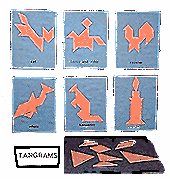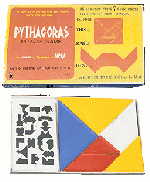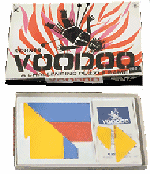
Originating in China prior to the 18th century, little is known of the true origins of this puzzle. The Chinese name for the puzzle is Chi-Chiao which has been translated into English as The Seven Clever Pieces or The Seven Wisdom Puzzle. The puzzle has considerable popular appeal in China as evidenced by the puzzle silhouette problems appearing in Chinese language daily newspapers much as crossword puzzles appear in western language newspapers. During the 19th century and to this day Tangram Puzzles continue to be popular all over the world.
| Square | Rhomboid | Triangle | Triangle | Triangle | Triangle | Triangle |
|---|---|---|---|---|---|---|
 |
|
|
 |
 |
||
| 4cm | 3x2.5cm | 3x2x2cm | 3x2x2cm | 4.5x3x3cm | 6.4x4.5x4.5cm | 6.4x 4.5x4.5cm |
The Museum's walnut copy of the puzzle (pictured above) was purchased in 1975 from World Wide Games, Delaware, Ohio. Along with the table-top version, a somewhat larger wall hanging version with a metal frame and magnetic pieces was also acquired from this manufacturer.

Here are some examples of what might be constructed from the seven pieces. These silhouettes are the type that appear in Chinese language publications, and in a number of books in many countries (for example Tangrams - Penguin Books ISBN 0041818). Photos and information concerning historic examples of this puzzle can be found in Pieter van Delf & Jack Botermans, Creative Puzzles of the World, New York: Harry N. Abrams, Inc., 1978, pages 12-16; and Jerry Slocum & Jack Botermans, Puzzles Old & New, Seattle: University of Washington Press, 1992, pages 23-25.
A somewhat surprising reference concerning this puzzle is Robert Van Gulik, The Chinese Nail Murders, University of Chicago Press, 1961, ISBN 0-226-84863-9. This is a mystery story, and fingering the murderer involves solving a Tangram puzzle. Some editions of this book include cardboard copies of the puzzle for a readers use!
The Museum collection also includes a number of contemporary boxed plastic versions of the Tangram Puzzle, each patented under a different name. For example:
 |
Pythagoras: Acquired in 1970. Tangram Puzzles with the name "Pythagoras" first appeared on the market in the 19th century. In this contemporary version the seven plastic pieces are in different colors. The box includes pictures of 140 silhouettes, and a frame approximately 12cm square in which to construct the puzzle. The manufacturer is Kohner Bros., Inc. - Tryne Game Division, East Paterson, New Jersey. |
 |
Voodoo: Also acquired in 1970, manufactured by Kohner Bros., Inc. - Tryne Game Division, East Paterson, New Jersey, this puzzle appears to be the same as the classic Tangram Puzzle, but the astute viewer will note that it is somewhat different. There are seven colored plastic pieces, but these geometric forms differ from the seven classic Tangram shapes! This puzzle is similar to a popular puzzle the first appeared in 1899 and was a favorite (according to Slocum & Botermans, page 30) with both English and German troops in World War I, know under the name The Sphinx. |
NOTE: This page was originally created and posted on the Web on October 6, 1997. Subsequently it has been modified and periodically updated. Last update April 11, 2010